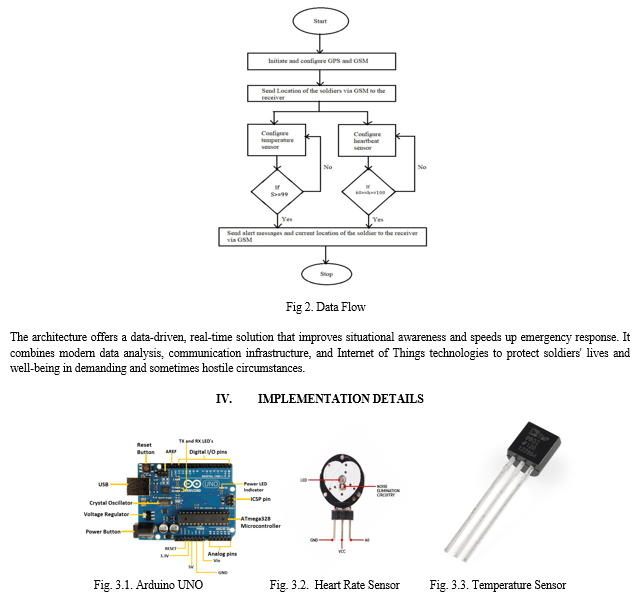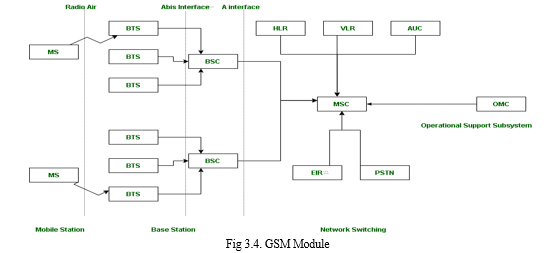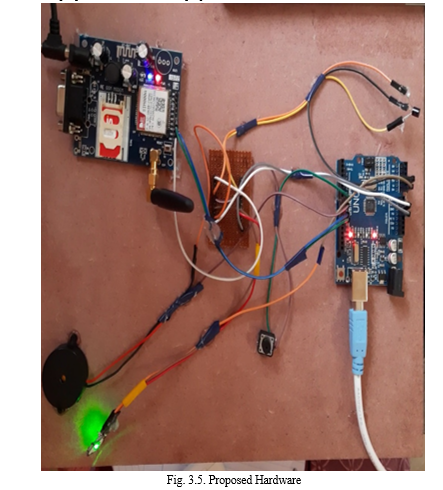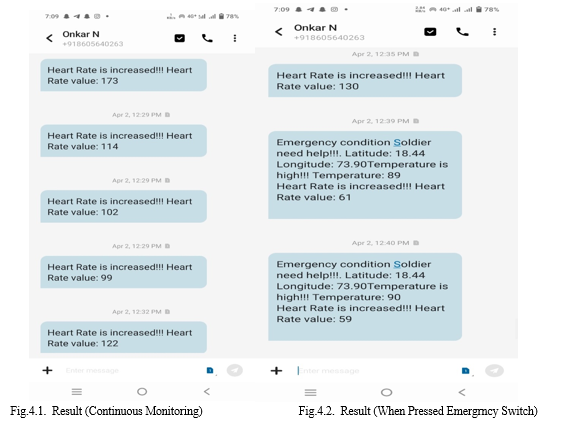Ijraset Journal For Research in Applied Science and Engineering Technology
- Home / Ijraset
- On This Page
- Abstract
- Introduction
- Conclusion
- References
- Copyright
SafeGuard: IOT - Based Health and Soldier Tracking System
Authors: R. S. Meshram, H. V. Kapse, O. U. Nangare, S. A. Shinde, K. A. Pawar
DOI Link: https://doi.org/10.22214/ijraset.2024.59918
Certificate: View Certificate
Abstract
These days, a nation\'s battleground is essential to its security. The soldiers in the army play a major role. There have been several actions made to protect the soldiers. Therefore, numerous equipment is mounted on horses to monitor their health in order to ensure their safety. Bioprocess systems facilitate low-cost wearable, discreet health monitoring options by combining several biosensor types, transmission technologies, and processing powers. GPS is used to determine latitude and longitude, making it easy to determine the soldier\'s direction. In order for base stations to be able to monitor their soldiers in real time, these devices are being attached to weapons and clothing. The Israeli Army, for example, is investigating the possibility of embedding GPS trackers inside soldiers\' vests and uniforms. Several intelligent sensors that are affixed to a soldier\'s body are employed in this system. The base station will use a wireless connection to provide connectivity. The GSM module that the soldiers would carry will aid in facilitating their contact with the army station base. The idea of tracking a soldier and learning about his situation during a fight is the focus of the project\'s proposed system. Software and hardware are integrated to implement the system.
Introduction
I. INTRODUCTION
In the modern era of warfare and military operations, ensuring the safety, well-being, and effectiveness of soldiers is paramount. To address this need, the integration of cutting-edge technology has led to the development of Soldier Tracking and Health Monitoring Systems. These systems represent a significant leap forward in enhancing the capabilities of military units by providing real-time insights into the location, physiological condition, and environmental factors affecting each soldier. This project aims to delve into the intricacies of these advanced systems, their components, functionalities, and the invaluable benefits they bring to military operations.
The primary objective of this project is to explore the various components and functionalities of Soldier Tracking and Health Monitoring Systems. By examining the role of each technology, from biometric sensors that monitor heart rate and body temperature to GPS tracking that provides precise location data, we aim to highlight the holistic approach these systems take toward soldier safety. Additionally, we will delve into the data analysis and visualization techniques that enable medical personnel and commanders to interpret the collected data effectively. The implementation of Soldier Tracking and Health Monitoring Systems holds immense promise for revolutionizing military operations. This project will shed light on the advantages these systems offer, including improved situational awareness, rapid response to medical emergencies, enhanced strategic decision-making, and reduced risks to soldiers' lives. Moreover, the project will touch on the ethical considerations associated with data collection and privacy in military contexts, as the deployment of such technology necessitates careful balancing of security and individual rights.
In modern military operations, ensuring the well-being and safety of soldiers in the field is of paramount importance] Soldiers are frequently exposed to physically demanding environments, potentially hostile situations, and remote locations, making real-time health monitoring and tracking a critical requirement. The challenge is to develop an integrated system leveraging Internet of Things (IoT) technologies that can continuously monitor the health status of soldiers, track their locations, and relay this vital information to commanders and medical personnel, thereby enhancing situational awareness and the ability to respond promptly to emergencies.
The heart of the Soldier Health and Position Tracking System is a sophisticated network of interconnected devices, sensors, and communication systems, all powered by IoT technology. Wearable devices equipped with sensors constantly collect data on soldiers' vital signs, including heart rate, body temperature, blood pressure, and even stress levels. These devices are designed to withstand harsh environmental conditions, ensuring that data remains reliable even in extreme circumstances. Additionally, GPS and GSM technology provides real-time geographic positioning data, allowing commanders to monitor the precise location of each soldier.
II. RELATED WORK
Mr. Yashash Jain , Mr. Bhupesh Soni [1] This paper presents wearable technology for soldiers to monitor their health on battlegrounds using IoT.
•LoRa: Long Range communication
•MANET: Mobile Ad Hoc Network
Ms. G. Navya, Ms. K. Priyanka [2] The system uses abnormalities in wireless body area sensor networks (WBASNs) to establish a connection between soldiers and base units, sending current location and health status to receivers.
Ms. Archana Padikar A, Cinmayee C K [3] Various instruments are worn on horsebacks to monitor their medical conditions. Bioprobes systems use biosensors and GPS to provide low-cost wearable health monitoring solutions.
Ms. R. Vithiya , Ms. S. Karthika [4] This paper discusses the use of the Internet of Things (IoT) to track and locate survivors in remote locations during natural conflicts.
Ms. Harsha S, Mr. Khalid Nazim S. A. [5] Autonomous systems like UNISol are replacing soldiers in war fields, performing human-like tasks. This system uses deep learning techniques for threat detection and tracking, reports threats to personnel via secure wireless connections, and can be controlled and managed by personnel through a user interface
III. SYSTEM ARHITECTURE
The "Safe Guard" IoT-Based Health and Soldier Tracking System is a sophisticated architecture designed to ensure the safety and well-being of military personnel in the field. This system combines various components to create a comprehensive solution.

The SafeGuard IoT-Based Health and Soldier Tracking System is a comprehensive and detailed architecture designed to ensure the health and safety of military personnel in the field. The system's architecture is divided into various components, each serving a specific function, and it leverages IoT technology, real-time data processing, and secure communication channels.
Soldiers wear biometric sensors, GPS tracking devices, environmental sensors, and communication tools. These sensors continuously monitor vital signs, track their location, assess environmental conditions, and facilitate communication with the central system and commanders. Data from soldiers' wearable devices is transmitted to a central data center. This data center plays a pivotal role in data processing, analysis, and decision-making. It includes modules for data ingestion, processing, database management, a user interface for commanders, an emergency response system, and geospatial mapping. The command center is where military commanders make informed decisions based on the real-time data received. They can monitor soldiers' health and positions, communicate with them, plan and execute missions, and coordinate medical support and evacuations. Security measures are integrated to protect data and communication channels against potential threats.
The Arduino Uno is the primary component in the suggested setup. The Arduino Uno is an open-source microcontroller board that was created by Arduino.cc and first made available in 2010. It is based on the Microchip ATmega328P microprocessor (MCU). Sets of digital and analog input/output (I/O) pins on the microcontroller board allow it to be interfaced with different expansion boards (shields) and other circuits.
The board may be programmed using the Arduino IDE (Integrated Development Environment) and a type B USB cable. It includes six analog and fourteen digital I/O pins, six of which can be used for PWM output. It can be powered by a rectangular 9-volt battery or a barrel connector that takes voltages ranging from 7 to 20 volts. It shares the same headers as the Leonardo board and the same microprocessor as the Arduino Nano board. The Arduino website has the hardware reference design, which is made accessible under a Creative Commons Attribution Share-Alike 2.5 license. There are additional layout and production files available for certain hardware variants."Uno" signifies "one" in Italian and was selected to signify a significant overhaul of the Arduino hardware and software. The Uno board, the ninth in a line of USB-based Arduino boards, was the replacement for the Duemilanove release. Newer revisions of the Arduino IDE for the Arduino Uno board have superseded version 1.0. The board's ATmega328 is pre-programmed with a bootloader, enabling fresh code to be uploaded to it without the need for an external hardware programmer. The data flow diagram that follows demonstrates how the architecture is constructed through a series of steps:

Fig. 3.1: Arduino UNO: Arduino UNO is a popular microcontroller board widely used for prototyping and DIY electronics projects due to its simplicity and versatility.
Fig. 3.2: Heart Rate Sensor: A heart rate sensor detects and measures the heartbeat of an individual, commonly used in wearable devices for fitness tracking and health monitoring.
Fig 3.3: Temperature Sensor: A temperature sensor measures ambient temperature and provides digital or analog output, essential for environmental monitoring and control in various applications.
GSM:Global System for Mobile Communication

Fig. 3.4: In health and soldier tracking systems, GSM modules play a crucial role in enabling real-time communication between wearable devices and central servers, allowing for remote monitoring, emergency alerts, and location tracking via cellular networks.
In the proposed system, the Arduino Uno serves as the central processing unit, interfacing with sensors and communication modules to gather vital health metrics and location data in real-time. The temperature sensor continuously monitors ambient temperature, enabling early detection of heat-related illnesses such as heat stroke. Similarly, the heart rate sensor provides continuous monitoring of heart rate, allowing for prompt intervention in case of abnormal readings indicating potential health risks. The GSM module facilitates communication by transmitting health data and location updates to a central monitoring station or command center. By integrating these components, the system enables proactive health monitoring and precise tracking of soldiers, ensuring timely assistance and enhancing overall operational effectiveness and safety.
Using Embedded C language for dumping programs into Arduino Uno involves writing code in the C programming language to control the behavior of the microcontroller on the Arduino board. This code is then compiled and uploaded onto the Arduino Uno using the Arduino IDE or other compatible development environments.
The Embedded C code typically includes functions to initialize the microcontroller, configure input/output pins, implement desired functionality (such as reading sensor data or controlling actuators), and handle communication with external devices or sensors.
To deploy embedded C code onto an Arduino Uno, begin by connecting the board to the Arduino IDE, where the code will be written and compiled. Adhere to Arduino syntax and conventions to ensure compatibility. Once written, compile the code to generate a binary file, then upload it to the Arduino Uno via USB. The board's bootloader receives the binary, stores it in flash memory, and initiates execution upon reset. Monitor program output and behavior through the IDE's serial monitor for debugging and troubleshooting.
Deploying embedded C code onto an Arduino Uno involves writing, compiling, and uploading code using the Arduino IDE. After connecting the board and writing the code, compile it to generate a binary file. Upload the binary to the Arduino Uno via USB, where the bootloader stores it in flash memory and initiates execution upon reset. Monitor program output through the IDE's serial monitor for debugging.
When interfacing hardware components such as a temperature sensor, GSM module, and heart rate sensor with an Arduino Uno, it's essential to establish the necessary connections for proper communication and functionality. Firstly, for the temperature sensor, like the DHT11 or DS18B20, connections involve linking its data pin to a digital pin on the Arduino Uno, typically pin 2. Power (VCC) and ground (GND) connections are then established from the sensor to the 5V and GND pins on the Arduino Uno, respectively. To facilitate temperature readings, libraries such as DHT.h are utilized to interact with the sensor efficiently.
Similarly, integrating a GSM module like the SIM900 or SIM800 involves establishing serial communication between the module and the Arduino Uno. This entails connecting the TX pin of the GSM module to the RX pin (pin 0) on the Arduino Uno and vice versa. Power and ground connections are made from the GSM module to the 5V and GND pins on the Arduino Uno. It's worth noting that SoftwareSerial library usage is necessary to communicate with the GSM module via the Arduino Uno's digital pins, as the hardware serial pins (pins 0 and 1) are utilized for other purposes.
Lastly, incorporating a heart rate sensor, such as the Pulse Sensor, requires connecting its analog output pin to one of the Arduino Uno's analog pins, commonly A0. Power and ground connections from the sensor are made to the 5V and GND pins on the Arduino Uno, respectively. Analog readings from the heart rate sensor are obtained using the analogRead() function, enabling the conversion of analog signals into meaningful heart rate values.
By adhering to proper wiring diagrams, utilizing relevant libraries, and referring to datasheets for accurate pinouts, seamless integration of these hardware components with the Arduino Uno can be achieved, facilitating the development of diverse applications ranging from health monitoring to IoT solutions.
Following picture shows the proposed hardware for the project:

V. RESULTS AND DISCUSSIONS

Above shown pictures are the results for appropriate and intentional working of GSM Module used for the project. The paper shows the outcomes that are obtained after executing the project successfully. Fig. 4.1. shows the results of continuous monitoring of a soldier body while it jumps above the normal conditions. Fig. 4.2. shows the results for an emergeency action taken by the soldier by pressing the emergency switch provided in the hardware itself.
VI. FUTURE SCOPE
The future scope of the SafeGuard IoT-Based Health and Soldier Tracking System is promising, with potential advancements in technology and military operations. Future developments may involve the integration of advanced wearable sensors and biometric devices, such as biofeedback systems for stress management, and the incorporation of AI and machine learning for more accurate health predictions. Enhanced data analytics, including predictive analytics, could further improve mission planning and resource allocation. Additionally, the system could be expanded to support multi-domain operations, allowing seamless coordination between land, air, and sea forces. The integration of emerging technologies like 5G and edge computing may enhance real-time data processing and connectivity, ensuring that the system remains at the forefront of safeguarding soldiers' well-being and mission success.
Conclusion
Based on the aforementioned implementation, we have concluded that GSM is used to overcome communication barriers between soldiers and base unit authorities; GPS and wireless body area sensor network (WBASNS) are used to determine precise location and health parameters, respectively; and GSM modem is used to transmit all information to the base station so that the field commander can take the appropriate action. If a soldier\'s health metrics exceed a threshold value or their coordinates leave a predetermined, tracked area, we can use enhanced versions of the GSM module to initiate an emergency call and provide soldiers with real-time answers to their difficulties on the battlefield.
References
[1] Archana Padikar A, Cinmayee C K, Chaithra E, Chethan, Puneeth Kumar D N- International Journal of Engineering Research & Technology (IJERT) ISSN: 2278-0181 Published by, www.ijert.org NCETESFT - 2020 Conference Proceedings [2] Sweta Shelar, Nikhil Patil, Manish Jain, Sayali Chaudhari, Smita Hande (8th March, 2015).” Soldier Tracking and Health Monitoring Systems”. Proceedings of 21st IRF International Conference, Pune India. ISBN: 978-93-82702-75-7 pages: 82- 87 [3] Dineshwar Jaiswar, Sanjana S. Repal (2015, July).”Real Time Tracking and Health Monitoring of Soldier using ZigBee Technology”. International Journal of Innovative Research in Science, Engineering and Technology: a Survey. Vol 4, Issue 7 pages 5560-5574 [4] Shruti Nikam, Supriya Patil, Prajakta Powar, V.S.Bendre.”GPS Based Soldier Tracking and Health Indication System”. International Journal of Advanched Research in Electrical, Electronics and Instrumentation Engineering, Pune, Maharashtra, India. Vol 2, Issue 3. [5] Pangavne S. M., Choudhary Sohanlal & Pathak Bhavik (2015).”Real Time Soldier Tracking System”. IOSR Journal of Electronics and Communication Engineering (IOSR-JECE), Nashik, Maharashtra: pp. 21-24. [6] P.chakravarth, S.Natarajan, M.Anto Bennete “GSM based soldier tracking system and monitoring using wireless communication” Department of Electronics and Communication, published in September 1st, 2017. [7] Akshita v.Armarkar, Deepika J, Punekar, Mrunali, p.Kapse, Shweta Kumari, Jayshree Shelka “Soldier health and position tracking system” Department of ETC engineering , volume 7 issue no..3 [8] Patil Akshay , Shelake Balaji, Pinjari Raju, Mirajkar P.P “GPS based soldier tracking and health monitoring”, Department of ETC engineering, volume 40 issue:03 March 2017. [9] Shruthi Nikam, Supriya Patil, Prajkata Powar, V.S.Bendre “GPS based soldier tracking and health indication system”, Department of E&TC , PIMPRI CHINCHWAD COLLEGE OF ENGINEERING, volume 2, issue 3, March 2013.
Copyright
Copyright © 2024 R. S. Meshram, H. V. Kapse, O. U. Nangare, S. A. Shinde, K. A. Pawar. This is an open access article distributed under the Creative Commons Attribution License, which permits unrestricted use, distribution, and reproduction in any medium, provided the original work is properly cited.

Download Paper
Paper Id : IJRASET59918
Publish Date : 2024-04-06
ISSN : 2321-9653
Publisher Name : IJRASET
DOI Link : Click Here
 Submit Paper Online
Submit Paper Online

